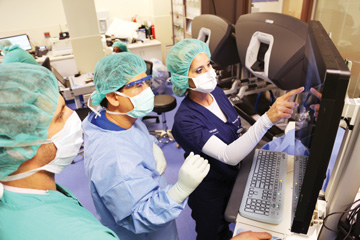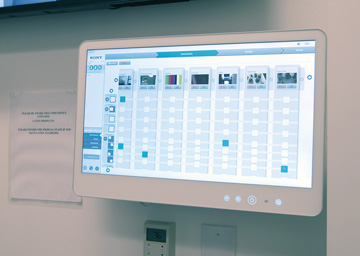At first, Dr. Dean used his integration platform only to route endoscope images to the large monitor hung on the OR wall. He then realized he could easily send video and clinical information throughout his practice, using the touchscreen interface
to broadcast to any screen in the facility. “Each monitor in the facility becomes a window into whatever digital output I have,” says Dr. Dean.
One of the first lessons he learned in medical school was that he has 10 minutes to walk into an exam room and make the patient feel comfortable enough to gain their trust and have confidence in his abilities to treat their ailment. His integrated
practice helps here, too. Instead of presenting clinical information on several platforms, Dr. Dean can send what he wants to share with patients to a single screen. He can pull in visual aids, videos of past procedures, images of the patient’s
anatomy and clinical studies to support the points he’s making and emphasize the importance of complying with the care plan.
Dr. Dean placed pan-tilt-zoom cameras in the OR and every exam room to record what happens during clinic appointments with patients without having another staff member present to witness the interactions, a necessity from a medico-legal perspective.
It also helps him conduct more productive assessments of patients. “Patients are more willing to openly share the information I need when it’s just us talking,” he points out. He can also monitor the OR being set up for the
next case from his office and arrive just in time to operate. Those extra few minutes allow him to be more productive between procedures.
During the pandemic, family members couldn’t come into the facility with their loved ones to offer important support before and after surgery. Dr. Dean has been able to FaceTime with family members and project their phone image onto the
large screen in the OR so they can talk with the patient. “We’ve all learned to live remotely over the past couple years,” says Dr. Dean. “The integration technology allows me to provide the same quality of care by
creating a welcoming environment even without a physical presence.”
Dr. Dean also came up with a reverse telemedicine concept to continue caring for patients during the pandemic. Patients would come into the clinic and a single staff member who was masked and vaccinated checked them in and hooked them up to diagnostic
testing equipment. He and other members of the care team would use the integrated camera and monitor set-up to interact with the patient remotely from another exam room. “Fewer people touched the patient,” says Dr. Dean. “The
pandemic reminded us that sick patients get sicker. We did our best to protect patients and have continued that practice for immunocompromised individuals.”
Many patients appreciate receiving a video recording of their procedure, especially as health care is becoming more transparent. “The recording provides documentation of what happened in the OR,” says Dr. Dean. “It makes them
feel like they’re more involved in their own care and that they have access to the record of their case. And as a surgeon, I appreciate the opportunity to show that I was able to deliver on what was promised.”
Integrated ORs have the potential to take surgical education to the next level, according to Dr. Ross. She’s working on a video-based assessment and education project for SAGES, exploring how to process the information and videos captured
during operations, break them down into individual critical steps and use artificial intelligence to improve outcomes of specific procedures. The goal is to assess outcomes based on factors such as the length of the procedure, surgical technique
used by the surgeon, the patient’s overall health and complications. “Researchers can look back at each step of the operation to determine what, if anything, the surgeon could have done to achieve a better result,” says Dr.
Ross.
The lessons could be used to coach the physician who performs an individual procedure, but also other surgeons when the results are analyzed in aggregate. “The data capture marries elements of surgery with outcomes with the aim of developing
a standardized approach to surgery that achieves best outcomes,” says Dr. Ross.
Facilities with integrated ORs will be able to compare the outcomes of individual surgeons and review the supplies, instruments and techniques they used to determine the best approaches for specific surgeries, according to Dr. Ross. “Leadership
could then approach other surgeons to see if they can incorporate some of the practices into their surgical routines,” she says. “Embracing quality and innovation is when technology becomes invaluable.”
The integrated system Dr. Dean uses features a 24-terabyte server, allowing him to catalogue a library of case videos, which he can access remotely through a secure web-based portal from his home or office instead of needing to keep track of numerous
encrypted USB drives. Rewatching his past cases makes him a better surgeon and teacher of innovative surgical techniques. “The remote access is more than simple convenience,” he says. “I wouldn’t watch as many videos
as I do now if I couldn’t get to them online.”
Seamless connectivity among the various components of a high-tech OR allows for the downloading, storing and reporting of outcomes data. “Integration improves surgical care,” says Dr. Dean. “If you extend the technology beyond
the clinical space, it becomes that much more powerful.” OSM
.svg?sfvrsn=be606e78_3)


.svg?sfvrsn=56b2f850_5)